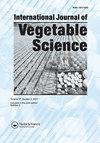冬瓜(Luffa acutangula Roxb.)结簇习性和果实表面形态的遗传
IF 1.1
Q2 Agricultural and Biological Sciences
引用次数: 0
摘要
丝瓜(acutangula)或丝瓜(ridge葫芦)一般产单生有棱或脊的果实,而雌雄同体的野生丝瓜(Satputia)产簇生无棱的果实。本研究以2个雌雄同体品系(长穗和小穗)和5个雌雄同体品系(DRG-2、Pusa Nasdar、Utkal triti、Arka Summet和HARG-110)的杂交为材料,测定了冬瓜的遗传群结习性和无棱果。结果表明,所有F1植株均为单株,果实呈脊状。结果表明,在F2代中,结实习性和果面形态的表型分布符合预期的3∶1(单生vs群聚)和15∶1(脊vs非脊)。分离模式提示单基因隐性基因控制果穗结实习性,而重复隐性基因控制棱形果面。本文章由计算机程序翻译,如有差异,请以英文原文为准。
Genetics of cluster bearing habit and fruit surface morphology in ridge gourd (Luffa acutangula Roxb.)
Luffa acutangula or ridge gourd generally produces solitary and ribbed or ridged fruit, but Satputia a feral form of ridge gourd with hermaphrodite sex form produces non-ribbed fruits in cluster. The present study was conducted to determine the inheritance cluster bearing habit and non-ridge fruit in ridge gourd from the crosses of two hermaphrodite lines (Satputia Long and Satputia Small) which produced small numerous non-ribbed fruits in cluster and five monoecious lines (DRG-2, Pusa Nasdar, Utkal Tripti, Arka Summet and HARG-110), produced solitary long fruit with ten prominent ridges. It was observed that all the F1 plants were solitary bearer and produced ridged fruit. In F2 generation, the observed distribution of plant phenotypes for bearing habit and fruit surface morphology fitted well to the expected ratio of 3:1 (solitary vs cluster) and 15:1 (ridge vs non-ridge) for bearing habit and fruit surface morphology, respectively. The segregation pattern suggested monogenic recessive control of cluster bearing habit, while duplicate recessive genes control ridged fruit surface in Luffa acutangula.
求助全文
通过发布文献求助,成功后即可免费获取论文全文。
去求助
来源期刊

International Journal of Vegetable Science
Agricultural and Biological Sciences-Plant Science
CiteScore
3.10
自引率
0.00%
发文量
30
期刊介绍:
The International Journal of Vegetable Science features innovative articles on all aspects of vegetable production, including growth regulation, pest management, sustainable production, harvesting, handling, storage, shipping, and final consumption. Researchers, practitioners, and academics present current findings on new crops and protected culture as well as traditional crops, examine marketing trends in the commercial vegetable industry, and address vital issues of concern to breeders, production managers, and processors working in all continents where vegetables are grown.
 求助内容:
求助内容: 应助结果提醒方式:
应助结果提醒方式:


